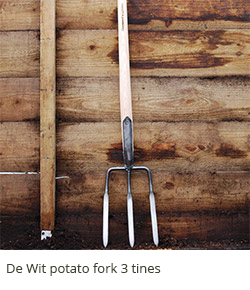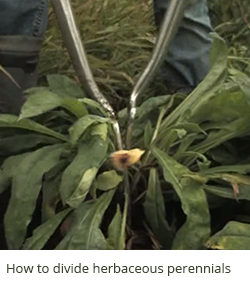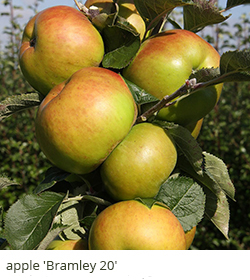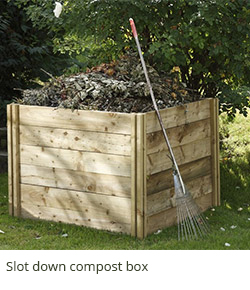Now that there’s an R in the month we can wave goodbye to summer and begin to plan for next spring because it’s time to think about bulbs. These may look uninspiring in their brown, papery coats, but they are primed to dazzle next spring and dazzle they will!
The stars of the show are definitely the tulips. They come in a rainbow of colours and a variety of forms - from sleek and curvaceous lily-flowered elegance, to perfectly formed egg, to frilly and swooning double and there are fringed types too, as crisp as a Coco Chanel jacket. The frilly parrots are like barmaids, leaning over a counter, and these flouncing lovelies generally look best on their own.
You can get six weeks of flower if you choose carefully, because Early Singles, Fosterianas and Early Doubles perform in the first half of April. The Triumph tulips, the most highly bred and colourful group, and the ones to grow if you want cut flowers, join the parade by mid-April. Triumphs are the glue when it comes to tulip displays and they should be included in every recipe because their colourful flowers are long lasting with thick, weather resistant petals. They are also shorter in stature, so adding Triumphs to the mix avoids the ‘soldiers standing on duty’ look. Most other tulips perform in May and they transform any garden because the first half of May is full of burgeoning foliage, yet there are few flowers on offer.
Planting Time
 Most bulbs go into the ground in September in order to catch the autumnal rains. However tulips are prone to a fungal disease named Tulip Fire. The spores are discouraged by cooler temperatures and this is the reason why tulip planting waits for colder conditions. They can be planted from early November onwards and will still flower well if planted around Christmas time. However tulips sell out quickly, so don’t dilly dally on the ordering. Get them now and store them somewhere cool and dry. Most bulbs go into the ground in September in order to catch the autumnal rains. However tulips are prone to a fungal disease named Tulip Fire. The spores are discouraged by cooler temperatures and this is the reason why tulip planting waits for colder conditions. They can be planted from early November onwards and will still flower well if planted around Christmas time. However tulips sell out quickly, so don’t dilly dally on the ordering. Get them now and store them somewhere cool and dry.
Colours
Select a colour theme that pleases you. It could be pinks and sultry blackcurrant shades, or golden brown with peaches and oranges, or pale yellow and almost black, or spring fresh yellows and whites, or a blend of mauve and purple with a splash of orange. Create your own colour palette and ring the changes from year to year. It’s one of the pleasures of gardening. You might use wallflowers as well. They coincide with tulips and share similar colours. Remember! Always use a Triumph tulip or two. They’re vital.
Pots or Ground?
 If scrabbling about in the borders in cold weather makes your teeth shudder, plant them in large pots instead. Plant and layer them up like a bulb lasagne, with layers of the same variety, putting the earlier ones at the top. Use rugged containers and a loam based compost. John Innes 3 is ideal. Water your pots well and then find them somewhere cool away from heavy rain, against a dry wall for instance, because your tulip bulbs need to begin to root. At this stage the roots need to be damp, not wet. Squirrels (and rats) love them so it makes sense to cover the pots with chicken wire. After six weeks, you can bring them into position and leave them in situ. Just one potful lifts a garden. If scrabbling about in the borders in cold weather makes your teeth shudder, plant them in large pots instead. Plant and layer them up like a bulb lasagne, with layers of the same variety, putting the earlier ones at the top. Use rugged containers and a loam based compost. John Innes 3 is ideal. Water your pots well and then find them somewhere cool away from heavy rain, against a dry wall for instance, because your tulip bulbs need to begin to root. At this stage the roots need to be damp, not wet. Squirrels (and rats) love them so it makes sense to cover the pots with chicken wire. After six weeks, you can bring them into position and leave them in situ. Just one potful lifts a garden.
If heavy tubs of mixed varieties are too arduous for you to manage and move, go for single pots containing ten bulbs of one variety. These can be arranged by doorways and this is a good way to try new varieties as an experiment. This technique is used at Great Dixter and as each potful fades, it’s replaced by later varieties. Grow them in plastic pots and drop them into slightly larger decorative ones, if you wish, but make sure there are drainage holes. All bulbous plants need good drainage and pot feet definitely help.
In the Ground
I like to use a hand trowel in the border and I aim for planting at twice the depth of the bulb – a good general rule for all bulbs. Restrict yourself to three, four or five tulip varieties in one area and lay them on the ground so that you get a random mixture, not separate blocks. This will look far more natural and will avoid the multi-coloured dolly mixture look. Summer borders are easier to plant up because they’ve been cut down in late September. I also segregate tulips from most narcissi, because by the time most tulips flower most narcissi are past their best. Late single Poet’s narcissi, named forms of N. poeticus, are the exception. They overlap with later tulips and never look scruffy after flowering.
Leave Them In
You don’t have to remove tulips when they’ve finished flowering in a border, because lots of varieties have a perennial tendency and return year on year, albeit with smaller flowers. Just cut them back to one leaf after flowering and get into the habit of making notes during early May. If some areas are getting thin on flower, you must write it down because you won’t remember later. Top up with new bulbs every three years or so.
Perennial Tulip Varieties
 The following will come back year after in the border. ‘Ballerina’ is a scented, terracotta coloured lily-flowered tulip and it picks up new rose foliage brilliantly well. It’s often used as a contrast with the purple ‘Negrita’ and the dappled mauve ‘Shirley’. ‘Shirley’ develops mottling after a couple of days, so don’t panic if she opens cream, colour will follow. You could also add the beetroot-flamed ‘Rem’s Favourite’ as well. The following will come back year after in the border. ‘Ballerina’ is a scented, terracotta coloured lily-flowered tulip and it picks up new rose foliage brilliantly well. It’s often used as a contrast with the purple ‘Negrita’ and the dappled mauve ‘Shirley’. ‘Shirley’ develops mottling after a couple of days, so don’t panic if she opens cream, colour will follow. You could also add the beetroot-flamed ‘Rem’s Favourite’ as well.
Viridiflora tulips have green streaked petals and some of them are hard to place. However the white and green ‘Spring Green’ looks superb among ferns and other woodlanders in dappled shade. Add ‘White Triumphator’, a virginal white lily-flowered tulip, and both will return. You could also use the new budgie green Triumph, ‘Evergreen’, although you might find yourself picking it for the house!
I’d also grow the plum shaded single ‘Prinses Irene’ and its double form, ‘Orange Princess’, as single varieties because they also flower earlier.
Colour Schemes – Ready to Plant Mixtures and Self-pick
Rich Reds
There are mixtures on offer, if you’re unsure. The Lipstick collection contains rich red lily-flowered ‘Merlot’ and the lighter red ‘Pallada’, a Triumph. ‘National Velvet’ (a late-April tulip with high gloss deep red petals) and ‘Couleur Cardinale’ a fragrant red Triumph with purple overtones, are both stunners as well.
Sultry Touches
There are purples and blacks in the Lustrous Tulip Collection and ‘Queen of Night’, another perennial performer, is the best known dark tulip. Dark tulips need a bright companion, whether it’s pinks or orange toned golds with browns. Other good sultry tulips include ‘Jan Reus’ and this is a warmer red-purple that glows in the garden. You could also grow ‘Havran’, ‘Ronaldo’, ‘Victoria’s Secret’ and ‘Burgundy’. All mix well with paler pinks. The Triumph tulips ‘Mistress’ and ‘Pink Diamond’ are both excellent in pot or border.
Pinks
There are many excellent pink tulips but they can be divided in to warm and cool toned pinks and the two don’t mix well unless they’re separated with a plum or purple tulip. Those with a Barbara Cartland tendency towards the strident include ‘Barcelona’ and ‘Don Quichotte’. Delicate pinks include ‘Rosalie’, a paler sport from ‘Don Quichotte’.
Brown Sugar and Spice
You’ll have to be quick to order ‘La Belle Epoque’, a many petalled tulip that hovers between peach, brown sugar and apricot, for it’s always snapped up quickly. Use it with golds and warm oranges, such as the fringed ‘Lambada’, or you could invest in the Brown Sugar Collection which also features ‘Orange Cassini’. I also rate ‘Apricot Beauty’, for its pale silver washed apricot petals, and ‘Brown Sugar’ for it golden demerara glow.
Fresh Whites and Yellows
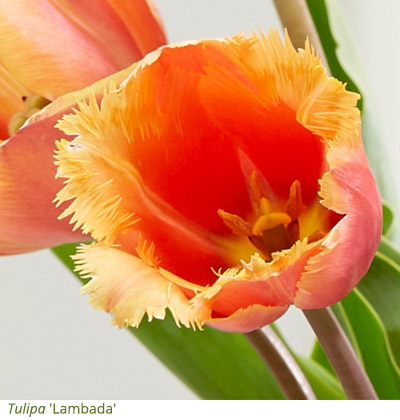 'Nicolas Hayek', a pallid yellow Triumph tulip is just the right colour to create a berry sorbet with the glowing beetroot-purple ‘Jan Reus’. Or use it with whites that might include ‘White Dream’. Or you could use the very early flowering ‘Purissima’. It opens white, but matures to pallid, moonlit yellow and then it takes on a languid look as the flowers open. Good in a box parterre, or on its own in containers. 'Nicolas Hayek', a pallid yellow Triumph tulip is just the right colour to create a berry sorbet with the glowing beetroot-purple ‘Jan Reus’. Or use it with whites that might include ‘White Dream’. Or you could use the very early flowering ‘Purissima’. It opens white, but matures to pallid, moonlit yellow and then it takes on a languid look as the flowers open. Good in a box parterre, or on its own in containers.
With so much choice, it’s time to go back to the drawing board and design your own planting scheme – with tulip time in mind!
|








